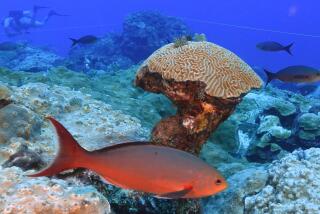Cultivating an Ocean Plantation : Marine Enthusiast’s Outlook Buoyed by Artificial Reef
- Share via
NEWPORT BEACH — A dripping Rodolphe Streichenberger emerged from the blue water off the Balboa Pier with an exuberant “ voila .”
He heaved handfuls of sticky, pink starfish--to be tossed overboard elsewhere--into the inflatable scuba craft and pronounced his 40-minute dive Saturday “excellent,” in English thick with the accent of his native France.
“We can feed the world,” said the enthusiastic Streichenberger, a youthful 68, after peeling off his scuba tank and face mask. “We can create jobs by the thousands, by the hundreds of thousands. It is all right here.”
Streichenberger, with help from Caltech scientist Wheeler North, is the founder of the Marine Forests Society, a 9-year-old nonprofit organization dedicated to creating a new marine habitat--a marine forest if you will--to feed the fish and replenish the thousands of acres of natural habitat that have been destroyed by humans.
Streichenberger, an economist by training, wants to create a new technology for “ranching” the sea bottom in coastal waters. It is a project he has begun with a prototype 200 yards off Newport Beach.
Beneath the waters lies what Streichenberger describes as an “underwater desert,” miles of barren sand, a perfect model to show his progress. “There is no life at all until we initiate it,” he said.
It is here where Streichenberger, shortly after arriving in Newport Beach in 1986, began his experiment using old automobile tires and plastic pipe. The tires, tied together in a line for 100 meters on the ocean bottom 40 feet below the surface, create a horizontal reef. The 100 20-foot pipes, anchored at one end and filled with air, do the same vertically.
Today, six years after they were installed, this reef of rubber and plastic already has become an enticement for a wide variety of marine life. Several varieties of sea bass hover around dark blue mussels and barnacles that cling by the thousands to the foundations, just as Streichenberger had planned.
Similar experiments in Chesapeake Bay involve creating a habitat for oysters and scallops. But for Streichenberger, the resilient, hearty mussels--which gravitate naturally to the reef--are his desired tool.
“Mussels are the best organisms to transfer energy from the tiny phytoplankton directly to the fish,” he said. “They are unique for that. The mussels eat the phytoplankton, then the fish eat the mussels, then other fish eat the fish.”
Mussels also survive all over the world, which gives his experiment an enormous potential for transfer anywhere, Streichenberger said.
“We don’t want to create a technique for a little corner of Newport Beach, we want something that can be used everywhere,” he said.
Streichenberger shrugs off naysayers as bureaucrats who want to monopolize the industry for themselves. Some contend the coastal waters cannot produce shellfish fit for human consumption, but he says he and his volunteers have often dined on mussels harvested from his reef.
And he scoffs at those who say tire rubber can emit toxic substances into the ocean, demanding they “show me some proof.”
“It is sabotage. It is deplorable,” Streichenberger said.
Next year, Streichenberger plans the second step in his experiment, that of harvesting his crop of mussels. With that knowledge, perhaps there will come a day when the United States is not importing 54% of its seafood, he said.
“I would like to see the United States exporting seafood, not importing it,” he said. “If we can create the technique, the entrepreneurs can take over.”
More to Read
Sign up for The Wild
We’ll help you find the best places to hike, bike and run, as well as the perfect silent spots for meditation and yoga.
You may occasionally receive promotional content from the Los Angeles Times.






